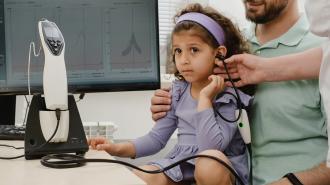Four children born with a rare form of deafness are now able to hear, thanks to a new gene therapy being trialed in China. In addition to helping others with the same condition, this treatment could one day lead to gene therapies for other, more common causes of deafness.
The challenge: Every year, about 6,000 babies are born in the US alone with some level of permanent hearing loss. The problem, in rare instances, lies in mutations in the gene that codes for the otoferlin (OTOF) protein, which helps hair cells in the inner ear transmit sounds to the brain for processing.
Cochlear implants — devices that send sound-simulating signals to the brain — can often help children with mutated OTOF genes cope with their hearing loss, but they can’t actually reverse deafness or replicate the experience of natural hearing.
“Now they can hear close to normal speech, and one can hear a whisper.”
Zheng-Yi Chen
What’s new? A new gene therapy designed to reverse hearing loss caused by faulty OTOF genes has now been tested in five children in China — and four of them are now able to hear.
“Before the treatment, if you put them in a movie theater with the loudest sound, they wouldn’t hear it,” Zheng-Yi Chen, an associate professor at Harvard Medical School, who helped design the study, told MIT Technology Review. “Now they can hear close to normal speech, and one can hear a whisper.”
The children who responded to the treatment have about 60-65% of normal hearing, according to lead researcher Yilai Shu, a professor in the department of otolaryngology at Fudan University in Shanghai.
How it works: The gene therapy uses a harmless virus to deliver unmutated copies of the OTOF gene into the inner ear.
Because this gene is too large to fit into the virus particle, the scientists split it into two parts. They filled millions of copies of the virus with the partial genes and then injected them directly into the cochlea.
Once in the ear, the two parts of the gene joined together and began instructing ear cells to produce the OTOF protein. It’s not yet known how long the effect will last, but it’s possible a single treatment could be enough to cure the problem permanently.
The children who responded to the treatment have about 60-65% of normal hearing.
More to come: Shu presented the cases of the first five children to receive the gene therapy at a meeting of the European Society for Gene and Cell Therapy in Brussels on October 27. His team has yet to publish their work, though, so details are scarce.
That means we don’t know for sure why one child didn’t respond to the treatment, but MIT Tech Review reports that they may have had preexisting immunity to the carrier virus. If that’s the case, packaging the gene therapy in a different virus might be enough to reverse hearing loss for that child and others like them.
The other guys: Shu’s team isn’t the only one attempting to reverse hearing loss by targeting OTOF mutations.
Regeneron Pharmaceuticals is also developing a gene therapy that uses a virus to deliver healthy copies of the OTOF gene into the inner ear. On October 26, it announced that the first child to receive the therapy has experienced improvements in hearing (though it didn’t say by how much). That trial is ongoing.
Eli Lilly subsidiary Akouos is developing a gene therapy for OTOF-caused deafness, too. It hasn’t tested the therapy in people yet, but is currently recruiting participants for a clinical trial in the US.
“It’s really important that we get the first gene therapy treatment right.”
Manohar Bance
The big picture: As for why multiple teams of researchers are focusing on this relatively rare mutation, rather than a more common cause of hearing loss, Manohar Bance, chief investigator for the Regeneron trial, said that it’s essentially the low-hanging fruit of genetic hearing loss.
“Gene therapy for otoferlin deficiency is the right starting point for young children because it’s among — if not the most — simple approaches for treating hearing loss,” said Bance, explaining that everything else in the child’s ear should be functioning normally.
“It’s really important that we get the first gene therapy treatment right because it will allow us to proceed to treating other genetic conditions,” he added.
We’d love to hear from you! If you have a comment about this article or if you have a tip for a future Freethink story, please email us at tips@freethink.com.
